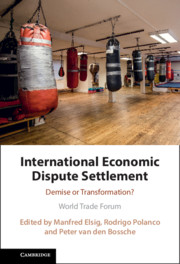Book contents
- International Economic Dispute Settlement
- International Economic Dispute Settlement
- Copyright page
- Contents
- Figures
- Tables
- Contributors
- Preface
- Abbreviations
- 1 Introduction
- 2 Contracting v. Multilateralism in Global Economic Governance
- Part I Current Challenges in International Trade Dispute Settlement
- Part II Current Challenges in International Investment Dispute Settlement
- 8 A Future Without (Treaty-Based) ISDS: Costs and Benefits
- 9 Investment Dispute Settlement à la carte: A Proposal for the Reform of Investor–State Dispute Settlement
- 10 Evidence-Guided Reform: Surveying the Empirical Research on Arbitrator Bias and Diversity in Investor–State Arbitration
- Part III New Issue Areas and Dispute Settlement
- Part IV Regional Approaches for International Economic Dispute Settlement
- Index
- References
9 - Investment Dispute Settlement à la carte: A Proposal for the Reform of Investor–State Dispute Settlement
from Part II - Current Challenges in International Investment Dispute Settlement
Published online by Cambridge University Press: 07 August 2021
- International Economic Dispute Settlement
- International Economic Dispute Settlement
- Copyright page
- Contents
- Figures
- Tables
- Contributors
- Preface
- Abbreviations
- 1 Introduction
- 2 Contracting v. Multilateralism in Global Economic Governance
- Part I Current Challenges in International Trade Dispute Settlement
- Part II Current Challenges in International Investment Dispute Settlement
- 8 A Future Without (Treaty-Based) ISDS: Costs and Benefits
- 9 Investment Dispute Settlement à la carte: A Proposal for the Reform of Investor–State Dispute Settlement
- 10 Evidence-Guided Reform: Surveying the Empirical Research on Arbitrator Bias and Diversity in Investor–State Arbitration
- Part III New Issue Areas and Dispute Settlement
- Part IV Regional Approaches for International Economic Dispute Settlement
- Index
- References
Summary
There is widespread consensus that investor–state dispute settlement (ISDS) is in need of reform. In late 2018, Working Group III of the United Nations Commission on International Trade Law (UNCITRAL), tasked with considering investor–state dispute settlement reform, agreed by consensus that reforming the current system of investor–state arbitration was “desirable” in order to address concerns relating to: (1) consistency, coherence, predictability, and correctness of arbitral rulings; (2) independence, impartiality, and diversity of decision-makers; and (3) costs and duration of proceedings (UNCITRAL 2018). Since then, delegations at UNCITRAL have started looking at potential solutions in order to address the concerns identified (Sachetim and Codeço 2019; UNCITRAL 2019a).
- Type
- Chapter
- Information
- International Economic Dispute SettlementDemise or Transformation?, pp. 220 - 263Publisher: Cambridge University PressPrint publication year: 2021

